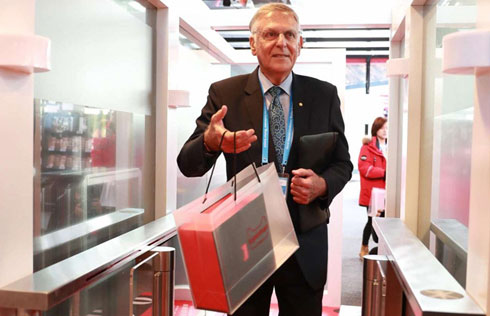Carmaker commits to continued advancement through echnology
German premium marque Audi is endeavoring to offer a safer, smarter and more efficient driving experience as it makes breakthroughs in self-driving vehicles.
Committed to Vorsprung durch Technik, or Advancement through Technology, Audi is arguably the most important pioneer in a field that used to exist only in science fiction.
In 2013, it became the world's first carmaker to get the nod to test a vehicle in Nevada with piloted driving technology.
One year later, Audi acquired licenses to test its self-driving vehicle on public roads in both Nevada and California.
The German automaker showcased its self-driving technology years earlier.
A self-driven Audi TTS nicknamed Shelley raced across the Bonneville Salt Flats in Utah at 210 km/h as early as 2009.
In 2010, Shelley braved the paved and gravel roads of Colorado's Pikes Peak at high speeds, including a 20 km section with 156 turns. The feat had never before been attempted by an autonomous vehicle.
The car covered nearly 5 km in 2 minutes and 30 seconds at California's Thunderhill race in 2012.
In 2013, Audi showcased its progress in automatic parking with a self-driving A7 sedan, which went from a road to an underground garage, found a parking lot, parked and then restarted, then drove out of the garage to stop in front of testing technicians.
In October 2014, the Audi RS 7 piloted driving vehicle lapped the Grand Prix circuit at Hockenheim at speeds of up to 240 km/h, making it the sportiest self-driving car in the world.
Earlier this year, a self-driving A7 sedan traveled about 900 km from Silicon Valley, California, to Las Vegas, Nevada, proving itself capable of driving in traffic as car users do on a daily basis, the carmaker said. A test run is also planned for Shanghai.
The autonomous concept relieves the driver of duties from 0 to 110 km/h. The car can initiate lane changes and passing maneuvers as well as accelerate and brake independently.
Before initiating a lane change, the vehicle adapts its speed to nearby vehicles. If the speed and distance calculation is deemed safe, the vehicle initiates the lane change with precision and in a timely manner.
The move is made possible with sensors that accurately detect the vehicle's surroundings.
Adaptive cruise control, Audi side assist, or ASA, long-range and mid-range radar sensors at the front and rear of the vehicle provide a 360-degree view of its environment.
Laser scanners are integrated into the front grille as well as the rear bumper to provide additional detailed recognition of static or dynamic objects.
"This tour is a masterpiece of Audi engineering and a new milestone in the history of piloted driving," said Ulrich Hackenberg, board member for technological management at Audi AG. "With our tour to Las Vegas, we have demonstrated that we do more than just showing pioneering technology. We are ready for piloted driving on public streets."
Leading tech
Also contributing to Audi's edge in piloted driving is the central driver assistance controller, known as the zFAS, which was tested on the road in 2014.
The zFAS processes information gathered by the sensors to create a detailed impression of the car's surroundings. Its online connection will then route this data to a Cloud-based IT backend.
There, the data will be processed using machine learning algorithms and artificial intelligence before it is transmitted back to the car.
The vehicle continually expands its intelligence as it drives, improving its performance in complex situations.
"The car itself permanently increases its knowledge, making this a form of continuous learning. With every mile it drives, every hour, every day and in every situation, the car is learning more and more - it becomes increasingly intelligent," said Ricky Hudi, executive vice-president of electronic development at Audi AG.
Other users of the technology could also benefit from this accumulation of information.
Audi will soon stage a world premiere of a car to further test its piloted driving.
It will feature e-tron technology and autonomous driving, a sign of the trends in the automaker's research and development.
The automaker has also shown its most recent advances in control and display technology in all new Audi Q7 and TT models.
One highlight is the virtual cockpit, powered by the T30 graphics processor made by Audi's cooperation partner NVDIA.
This fully digital combined instrument provides the driver with minutely rendered 3D graphics of all information and offers different display modes on its 12.3-inch TFT monitor.
The Audi all new TT and Q7 also feature MMI terminals with an all-new interface logic. The automaker said it will emulate the concept of modern smart phones, where flat hierarchies replace sprawling menu trees.
"With the MMI in the Audi all new TT and Q7, we are the first in the world to offer natural language control for the complete system," Hudi said.
He said the system understands expressions as used in everyday language, including simple commands such as "Where can I get gas?" or "Where is the nearest shopping mall?"
Hudi said the Audi all new Q7 and the TT are not the only models that equipped with the trailblazing innovation. "Our new masterpiece - the Audi prologue piloted driving- combines these latest technologies with all of our ideas for the future."
Audi has announced that it will equip its A8 sedans with autonomous driving technology from 2017.
The automaker said such functions as traffic jam assistant will control the speed and distance from the vehicle ahead and even take over steering during dense traffic on motorways at speeds of up to 65 km/h.
It added that the car's radar and laser systems as well as 12 ultrasonic sensors will offer a complete overview of the car's surroundings and thus ensure the highest level of safety.
Audi has also been a leading brand for automotive lighting technology. Groundbreaking innovations available in several current model lines include matrix LED headlights for intelligent and flexible illumination of the road surface as well as dynamic turning signals.
Another world first is the laser highbeam available in Audi's high-end R8 LMX edition model. It has also showcased Audi Matrix laser technology, a light that provides high-resolution and finely tuned illumination of the road ahead.
Hackenberg said Audi is making continuous efforts to shape the future of mobility with pioneering solutions. "As an innovation-focused carmaker, this is our mission. And this is what Vorsprung durch Technik stands for," he said.
lifusheng@chinadaily.com.cn

(China Daily 05/27/2015 page15)








